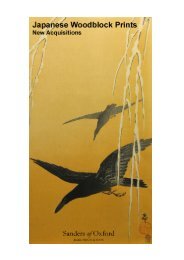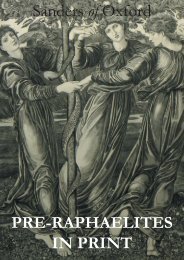Create successful ePaper yourself
Turn your PDF publications into a flip-book with our unique Google optimized e-Paper software.
Notable paintings <strong>of</strong> the theme include works by Kanô Sansetsu (1589/90-1651), Nakayama<br />
Kôyô (1717-80) and Yosa Buson (1716-84).<br />
24. Utagawa Kunisada [Utagawa Toyokuni III] (1786-1864)<br />
Scene from Hatsune [The First Warbler or The First Song], Chapter 23 <strong>of</strong> Genji<br />
monogatari [The Tale <strong>of</strong> Genji]<br />
Series: Genji gojûyon jô [Fifty-four Pictures <strong>of</strong> Genji]<br />
Date [Western]: 1852<br />
Date [Japanese]: Fifth Month <strong>of</strong> Kaei 5<br />
Signature: Toyokuni-ga<br />
Nanushi Censor Seal: Hama Yahei<br />
Publisher’s Seal: Sanoki<br />
School: Utagawa<br />
Method: Nishiki-e woodblock print<br />
Format: Chûban<br />
Condition; Good, some wear and fading<br />
Dimensions: 9 3/4 x 7 inches<br />
Code: SOX<br />
Price [Mounted]: £175<br />
This very short chapter in the Genji monogatari centres around an exchange <strong>of</strong> New Year’s<br />
greetings between Genji and the ladies <strong>of</strong> the Rokujô Mansion: Lady Murasaki [Murasaki no<br />
Ue] the Akashi Lady [Akashi no Ue], the Lady <strong>of</strong> the Orange Blossoms [Hanachirusato], the<br />
Safflower Lady [Suetsumuhana], and the Lady <strong>of</strong> the Locust Shell [Utsusemi]. In the<br />
chapter, Genji receives felicitous New Year delicacies in ‘bearded baskets’ [higeko, baskets<br />
with the ends <strong>of</strong> the woven strands left untrimmed] and, as depicted here, a warbler [uguisu]<br />
on an artificial pine branch, sent by the Akashi Lady, with whom he has a daughter, the<br />
future Akashi Empress [lower left]. Attached to the branch is a letter with a melancholy<br />
poem telling <strong>of</strong> her loneliness. Hatsune motifs are a constant <strong>of</strong> Japanese iconography,<br />
particularly within the decorative arts, because <strong>of</strong> their perceived auspicious symbolism.<br />
25. Utagawa Kunisada [Utagawa Toyokuni III] (1786-1864)<br />
Tori no koku [The ‘Hour’ <strong>of</strong> the Cock: 5 to 7 pm]<br />
Cartouche: A Group <strong>of</strong> Edoites by Toyohara Kunichika (1835-1900)<br />
Series: Shunyu jûniji [Twelve Hours <strong>of</strong> Spring Pleasure]<br />
Date [Western]: 1856<br />
Date [Japanese]: Third Month <strong>of</strong> Ansei 3<br />
Signature: Toyokuni-ga<br />
Censor Seal: aratame [‘examined’]<br />
Zodiacal Date Seal: tatsu san/dragon 3<br />
Publisher’s Seal: Yamaguchiya Tobei<br />
School: Utagawa<br />
Method: Nishiki-e woodblock<br />
Format: Single sheet ôban tate-e<br />
Condition: Excellent<br />
Dimensions: 15 x 10 inches<br />
Code: SOX<br />
Price [Mounted]: £375<br />
In Edo-period Japan, time was not measured in equal units, like the occidental hour. Instead,<br />
a day was split into day and night time, in accordance with sunrise and sunset, and then<br />
subsequently sub-divided into a further six segments, which, apart from at the two<br />
equinoxes, were unequal. The twelve ‘hours’ thus produced corresponded to the zodiacal<br />
animals used in calendrical numeration,<br />
Kunisada’s 1856 series explores and contrasts a courtesan’s day with that <strong>of</strong> the generic Edo<br />
chônin [townsmen], the latter being depicted in dinner-time scramble within a separate












